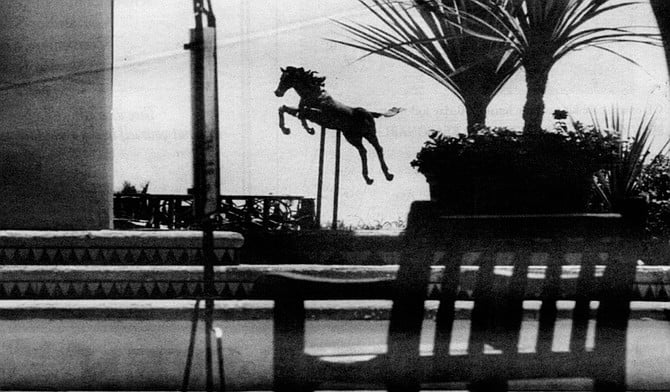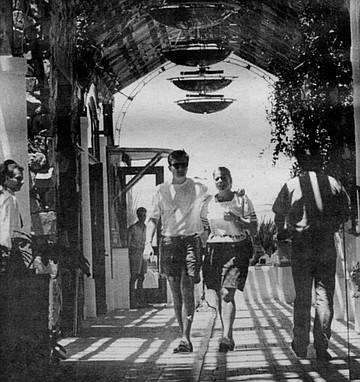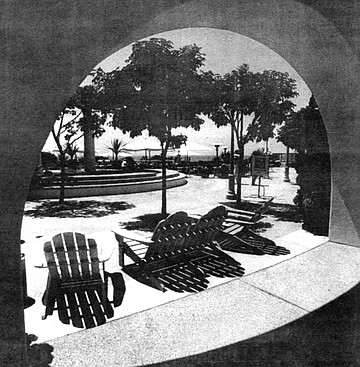 Facebook
Facebook
 X
X
 Instagram
Instagram
 TikTok
TikTok
 Youtube
Youtube

All over California, the 1960s-style mall that has defined so much of American suburban landscape over the last 30 years is undergoing revolution. Witness the new Del Mar Plaza, which opened in May 1989. A $30 million development covering 69,000 square feet at the intersection of 15th Street and Camino Del Mar, it styles itself as a “European retail village.” Gone, we gather, are megalomaniac spaces of yesteryear’s malls. Now shoppers wander quaint village streets festooned with flowers and bubbling fountains. For, it seems, the nostalgic pedestrian “plaza” is rapidly replacing the soulless, car-orientated mall. And just as California’s developers once dreamed of covering the land with bloated parking lots and anonymous L-shaped concrete blobs, so now they dream of covering it with exquisite simulacra of Mediterranean villages.

The Del Mar Plaza is the brainchild of David Winkler and Ivan Gayler, founders of a company called Del Mar Partnership. They developed the site with funding from Citicorp Real Estate, with the Ninteman company as contractors. However, permission for development in conservative and suspicious Del Mar was given only after more than 100 hours of public hearings. The developers had to assuage a certain amount of hostility, and this they did by selling off all the artifacts from the previous shopping strip on the site and donating proceeds to the Boys and Girls Club of Solana Beach, a nimble piece of PR that went some way to ingratiating them with the local community.

Designed by McCabe Gish of San Diego and the John Jerde Partnership of Los Angeles (who were also responsible for the L.A. Olympic stadium and San Diego’s Horton Plaza), Del Mar Plaza garnered all the awards from the beginning. In 1989 it picked up an Orchid Award of the local AIA (American Institute of Architects). It then went on to claim other awards from the Commercial Industrial Council, the Pacific Coast Builders’ Conference, and a body called the International Council for Shopping Centers.
The complex contains 35 shops, a community market, and four major restaurants, Il Fornaio, Epazote Baja Bar, Pacifica del Mar, and Johnny Rockets. Il Fornaio, of course, is a landmark, with its brassy terrace studded with winged horses and braziers. And its snazzy image is not let down by the daytime character of the rest of the “village.” (As the Plaza people told me, “We never use the M word!”) The Plaza’s maze of redwood, Malibu tile, Arizona flagstone, Bel Air stone, and Mexican shellstone does make a disconcertingly earnest attempt to re-create the intricacy and sheltered pedestrian calm of a smallish Provencal village. Even the elevator doors have a pretty veined-marble look. Piped classical music fills the air, no matter where you are. The Hugo Boss, Marylin Mulloy, and Laura Larkin stores nestle beneath Southwestern adobe-and-beam-style streets covered with greenery and flowers. Meanwhile, out on the wide sea-view terrace of the Enoteca bar, strange terra cotta figures by artist T.J. Dixon loll about in the fountains.
Says the charmingly offbeat Maggie Brown, the Plaza’s director of marketing, as she shows me around, “This is practically the only place in the area where you can sit out and actually enjoy the sea. It’s the brainchild of my boss, Ivan Gayler. People were telling him that he could rent the retail [space] for a fortune, but he was adamant. He wanted a ‘space for the people!’ ‘I want,’ he said, ‘a place where people could just hang out and enjoy the sea.’ So he came out here every day during construction and sat on every single square inch of it to make absolutely sure that from wherever he was sitting you could see the sea. He even had the railing lowered three inches so the view would be perfect. The problem is, people come here and get lost in the view. So I had that big arch built there to remind them that we have all these shops.” The arch and wall concerned have a terra cotta fellow leaning over the top, unfurling a painted sign below him that reads, “Canyon Garden Artisans Gallery Shops.” Alas, she says, Californians just don’t get the idea of walking into a square, catching sight of a little alley, and thinking, “Ah, that’s curious. Let’s, um, go down it and see what’s there.
“Other ideas didn’t really work. That Zen garden downstairs was originally a Japanese restaurant, but the INS came and busted the chefs. They were all illegal! And so we turned it into a French restaurant, and the Zen garden is actually a French patio. So much for all the Buddhistic SoCal idealism. The irony is, a lot of our customers are Japanese, because Jerde, the architect, has done a lot of work in Japan and, believe it or not, they come out to Del Mar just to shop in a Jerde building.”
Like so many developments in Southern California, the Plaza expresses a yearning and nostalgia for community. It wants to be a “community market,” assuming, probably correctly, that such things do not usually exist in small San Diego satellite towns. Cautious, insular Del Mar (where leaf blowers and beach bonfires are equally illegal) opposed the Plaza at first. Perhaps because the notion of “community” envisaged by most developers these days smacks not of Old World intimacy but of hugger-mugger commercial suburbia. The preconditions for planning permission went to almost ludicrous lengths. They included aerial surveys to calculate the height of all existing circumambient trees. Renowned landscape artist Emmet L. Wemple was then brought in to compose a formal rose garden and sprinkle the building with planter boxes, trellised vines, intimate groves of shade trees, and cascades of bougainvillea. Little bits of Belden brick complete the homey-pastoral feel. The end result? “An idealist’s dream,” says Gaylor, “of a community marketplace nestled in one of the most beautiful locations in the world.”
“Our thought,” said John Gish of McCabe Gish, the other architects involved, “was to bring into the plaza the textures, materials, and colors of the town of Del Mar itself. We wanted the building to grow out of the hill.”
When you remember that the Plaza sits in an area whose average per capita income is $71,600 and that 40,000 cars a day is the average traffic count, you know why the thing has turned into such a resounding success. Trish Mercurio of Peaches en Regalia, one of the clothing stores, calls it “a retailer’s dream.” Says Maggie, “This place absolutely had to be one of a kind. Everything about it is unique. There’s nothing like it anywhere else. We handpicked every tenant. Did you see the marble in Il Fornaio from Michelangelo’s quarry in Italy? That’s the kind of detail that’s gone into it. And it has what they call outstanding people spaces. It can’t miss.”
The small, hand-finished mall (so to speak) is the architectural and commercial future of California. Sonny Stern, a marketing consultant for major malls in the Del Mar area, says emphatically, “The big malls are dinosaurs. We’ll have a two-tiered retail world similar to the gasoline business. The smaller speciality center can provide better service and also relates to the community from an architectural and merchandising point of view.” The ’60s mall, then, will be replaced by the ’90s plaza — places like the Del Mar Plaza, with its dainty arrangements of jacaranda trees and pittosporum, its Craftsman-style redwood pergola and graceful arcades.
Says Gaylor, “It’s a model for the future retail village. The Palm Springs redevelopment agency toured our center because they are looking for a model for their downtown renovation. And the Japanese have been here with their video cameras. They may take creative ideas home with them and bring them to fruition there.”
The brochure tells us that the Plaza encapsulates “a thousand years of grand European tradition.” No doubt this will stand it in good stead among the solid burghers of Del Mar. That, of course, and the pizza ovens from Italy.


All over California, the 1960s-style mall that has defined so much of American suburban landscape over the last 30 years is undergoing revolution. Witness the new Del Mar Plaza, which opened in May 1989. A $30 million development covering 69,000 square feet at the intersection of 15th Street and Camino Del Mar, it styles itself as a “European retail village.” Gone, we gather, are megalomaniac spaces of yesteryear’s malls. Now shoppers wander quaint village streets festooned with flowers and bubbling fountains. For, it seems, the nostalgic pedestrian “plaza” is rapidly replacing the soulless, car-orientated mall. And just as California’s developers once dreamed of covering the land with bloated parking lots and anonymous L-shaped concrete blobs, so now they dream of covering it with exquisite simulacra of Mediterranean villages.

The Del Mar Plaza is the brainchild of David Winkler and Ivan Gayler, founders of a company called Del Mar Partnership. They developed the site with funding from Citicorp Real Estate, with the Ninteman company as contractors. However, permission for development in conservative and suspicious Del Mar was given only after more than 100 hours of public hearings. The developers had to assuage a certain amount of hostility, and this they did by selling off all the artifacts from the previous shopping strip on the site and donating proceeds to the Boys and Girls Club of Solana Beach, a nimble piece of PR that went some way to ingratiating them with the local community.

Designed by McCabe Gish of San Diego and the John Jerde Partnership of Los Angeles (who were also responsible for the L.A. Olympic stadium and San Diego’s Horton Plaza), Del Mar Plaza garnered all the awards from the beginning. In 1989 it picked up an Orchid Award of the local AIA (American Institute of Architects). It then went on to claim other awards from the Commercial Industrial Council, the Pacific Coast Builders’ Conference, and a body called the International Council for Shopping Centers.
The complex contains 35 shops, a community market, and four major restaurants, Il Fornaio, Epazote Baja Bar, Pacifica del Mar, and Johnny Rockets. Il Fornaio, of course, is a landmark, with its brassy terrace studded with winged horses and braziers. And its snazzy image is not let down by the daytime character of the rest of the “village.” (As the Plaza people told me, “We never use the M word!”) The Plaza’s maze of redwood, Malibu tile, Arizona flagstone, Bel Air stone, and Mexican shellstone does make a disconcertingly earnest attempt to re-create the intricacy and sheltered pedestrian calm of a smallish Provencal village. Even the elevator doors have a pretty veined-marble look. Piped classical music fills the air, no matter where you are. The Hugo Boss, Marylin Mulloy, and Laura Larkin stores nestle beneath Southwestern adobe-and-beam-style streets covered with greenery and flowers. Meanwhile, out on the wide sea-view terrace of the Enoteca bar, strange terra cotta figures by artist T.J. Dixon loll about in the fountains.
Says the charmingly offbeat Maggie Brown, the Plaza’s director of marketing, as she shows me around, “This is practically the only place in the area where you can sit out and actually enjoy the sea. It’s the brainchild of my boss, Ivan Gayler. People were telling him that he could rent the retail [space] for a fortune, but he was adamant. He wanted a ‘space for the people!’ ‘I want,’ he said, ‘a place where people could just hang out and enjoy the sea.’ So he came out here every day during construction and sat on every single square inch of it to make absolutely sure that from wherever he was sitting you could see the sea. He even had the railing lowered three inches so the view would be perfect. The problem is, people come here and get lost in the view. So I had that big arch built there to remind them that we have all these shops.” The arch and wall concerned have a terra cotta fellow leaning over the top, unfurling a painted sign below him that reads, “Canyon Garden Artisans Gallery Shops.” Alas, she says, Californians just don’t get the idea of walking into a square, catching sight of a little alley, and thinking, “Ah, that’s curious. Let’s, um, go down it and see what’s there.
“Other ideas didn’t really work. That Zen garden downstairs was originally a Japanese restaurant, but the INS came and busted the chefs. They were all illegal! And so we turned it into a French restaurant, and the Zen garden is actually a French patio. So much for all the Buddhistic SoCal idealism. The irony is, a lot of our customers are Japanese, because Jerde, the architect, has done a lot of work in Japan and, believe it or not, they come out to Del Mar just to shop in a Jerde building.”
Like so many developments in Southern California, the Plaza expresses a yearning and nostalgia for community. It wants to be a “community market,” assuming, probably correctly, that such things do not usually exist in small San Diego satellite towns. Cautious, insular Del Mar (where leaf blowers and beach bonfires are equally illegal) opposed the Plaza at first. Perhaps because the notion of “community” envisaged by most developers these days smacks not of Old World intimacy but of hugger-mugger commercial suburbia. The preconditions for planning permission went to almost ludicrous lengths. They included aerial surveys to calculate the height of all existing circumambient trees. Renowned landscape artist Emmet L. Wemple was then brought in to compose a formal rose garden and sprinkle the building with planter boxes, trellised vines, intimate groves of shade trees, and cascades of bougainvillea. Little bits of Belden brick complete the homey-pastoral feel. The end result? “An idealist’s dream,” says Gaylor, “of a community marketplace nestled in one of the most beautiful locations in the world.”
“Our thought,” said John Gish of McCabe Gish, the other architects involved, “was to bring into the plaza the textures, materials, and colors of the town of Del Mar itself. We wanted the building to grow out of the hill.”
When you remember that the Plaza sits in an area whose average per capita income is $71,600 and that 40,000 cars a day is the average traffic count, you know why the thing has turned into such a resounding success. Trish Mercurio of Peaches en Regalia, one of the clothing stores, calls it “a retailer’s dream.” Says Maggie, “This place absolutely had to be one of a kind. Everything about it is unique. There’s nothing like it anywhere else. We handpicked every tenant. Did you see the marble in Il Fornaio from Michelangelo’s quarry in Italy? That’s the kind of detail that’s gone into it. And it has what they call outstanding people spaces. It can’t miss.”
The small, hand-finished mall (so to speak) is the architectural and commercial future of California. Sonny Stern, a marketing consultant for major malls in the Del Mar area, says emphatically, “The big malls are dinosaurs. We’ll have a two-tiered retail world similar to the gasoline business. The smaller speciality center can provide better service and also relates to the community from an architectural and merchandising point of view.” The ’60s mall, then, will be replaced by the ’90s plaza — places like the Del Mar Plaza, with its dainty arrangements of jacaranda trees and pittosporum, its Craftsman-style redwood pergola and graceful arcades.
Says Gaylor, “It’s a model for the future retail village. The Palm Springs redevelopment agency toured our center because they are looking for a model for their downtown renovation. And the Japanese have been here with their video cameras. They may take creative ideas home with them and bring them to fruition there.”
The brochure tells us that the Plaza encapsulates “a thousand years of grand European tradition.” No doubt this will stand it in good stead among the solid burghers of Del Mar. That, of course, and the pizza ovens from Italy.
Comments